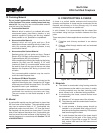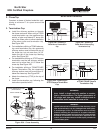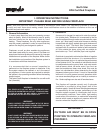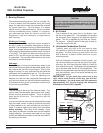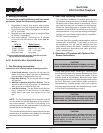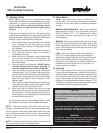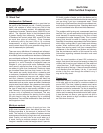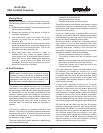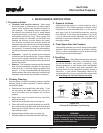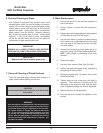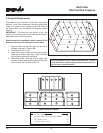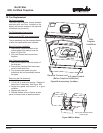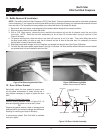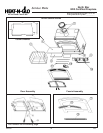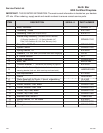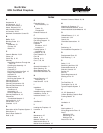Special offers from our partners!

Find Replacement BBQ Parts for 20,308 Models. Repair your BBQ today.

4-03 27 480-1081
North Star
EPA Certied Fireplace
J. MAINTENANCE INSTRUCTIONS
WARNING!
A chimney re can permanently damage your chimney
system. This damage can only be repaired by replacing the
damaged component parts. Chimney res are not covered
by the Limited Lifetime Warranty.
SCREW
REMOVE (4) SCREWS
AND LIFT TOP
PAN OFF.
CAP
SLIP
SECTION
TR342, TR344
ROUND TERMINATION CAPS
ST375
SQUARE
TERMINATION CAP
LIFT UP TO
REMOVE.
SCREW
CHASE
CAP
1. REMOVE THE 4 SCREWS.
2. REMOVE SCREEN.
3. REMOVE BAFFLE.
TS345
SQUARE
TERMINATION CAP
Figure 27A
Chimney & Termination Cap Cleaning
2. Chimney Cleaning
If you do detect a buildup of creosote, contact a qualied
chimney sweep or clean it yourself. To do this, perform
the following steps:
a. Remove the rst manifold tube and bafe. If you
do not remove the bafe, residue can pile up on
top of the bafe, and the replace will not work
properly.
b. Keep doors shut to prevent dirt and soot from
entering the room.
c. Remove the termination cap or housing top.
d. Clean with a stiff nylon brush attached to a pole OR
tie a small burlap bag lled with straw and several
small stones or sand. Work up and down the ue
until the ue is clean.
e. Replace the termination cap or housing top.
f. Reinstall bafe and manifold tube after cleaning.
4. Clear Space Near the Fireplace
Combustible materials must not be stored on the hearth
extension. Room furnishings such as drapes, curtains,
chairs, or other combustibles must be at least four feet
from the open front of the replace.
3. Disposal of Ashes
Ashes should be placed in a metal container with a
tight-tting lid. The closed container of ashes should
be placed on a noncombustible oor or on the ground,
well away from all combustible materials, pending
nal disposal. If the ashes are disposed of by burial
in soil or otherwise locally dispersed, they should be
retained in the closed container until all embers have
thoroughly cooled.
5. Overring:
Do not overre. Using ammable liquids or too much
wood, burning trash in the stove, or allowing too much
air into the replace, may result in overring. If the
replace glows red or even worse, white, the replace
is overred. This condition may ignite creosote in the
chimney, which can be dangerous, possibly causing a
house re. If you overre, immediately close the air
controls and door, if open, to reduce the air supply to the
re. Overring will void the replace warranty.
1. Creosote and Soot
a. Formation and need for removal: When wood
is burned slowly, it produces tar and other organic
vapors which combine with expelled moisture to
form creosote. The creosote vapors condense in
the relatively cool chimney ue of a newly-started
or a slow-burning re. As a result, creosote residue
accumulates on the ue lining. When ignited, this
creosote creates an extremely hot re which may
damage the chimney or even destroy the home.
The chimney connector and chimney should be
inspected once every two months during the heating
season to determine if a creosote or soot buildup
has occurred. If creosote or soot has accumulated,
it should be removed to reduce the risk of a chimney
re.
b. Inspection: Inspect the system at the replace
connection and at the chimney top. Cooler surfaces
tend to build creosote deposits quicker, so it is
important to check the chimney from the top as well
as from the bottom.
c. Removal: The creosote or soot should be removed
with a brush specically designed for the type of
chimney in use. A chimney sweep can perform this
service. It is also recommended that before each
heating season the entire system be professionally
inspected, and cleaned and repaired if necessary.



